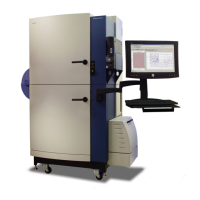FLIPR
®
Tetra High Throughput Cellular Screening System User Guide
0112-0109 H 171
About the Fluorescent Dye
Contents of the FLIPR
®
Calcium Assay Kit are optimized to give robust
results when used on a FLIPR
®
Tetra System according to protocol
provided in the kit. Benefits include:
• Increased assay signal
• Reduced background
• Increased z-factor
• Drastically reduced addition artifact (“dip”).
Dye is excited using the FLIPR
®
Tetra System LED Module, 470–495
nm. Signal is detected using the standard 515–575 nm emission filter
included with every FLIPR
®
Tetra System. Additional emission filters are
not required.
About Exchange Protein Inhibitors
Some cell types use mechanisms such as anion exchange proteins to
export anionic molecules from cells, including anionic forms of
fluorescent dyes. This will result in poor dye loading. Therefore, it may
be critical to inhibit the anion exchange protein to produce a successful
intracellular calcium assay on the FLIPR
®
Tetra System.
Probenecid is an anion exchange protein inhibitor. When added to
loading buffer, it may increase dye retention in cells. CHO-K1 is an
example of a cell type known to require probenecid. Although
FLIPR
®
pipette tips, 96, 384, or 1536 gasket See Appendix C.
Cells in suspension —
Test compounds Specific to receptor.
Growth medium Major laboratory supplier
(MLS)
Incubator (5% CO
2
, 37 °C) MLS
Centrifuge MLS
Pipettor and sterile tips suitable for use with
microplates
MLS
Probenecid in powder form Sigma
1 N NaOH Sigma
Item Source
Note: The Kit includes masking dye technology covered by issued and
pending patents including US 6,420,183, US 7,063,952 and EP
0,906,572, licensed exclusively from Bayer AG to Molecular Devices.

